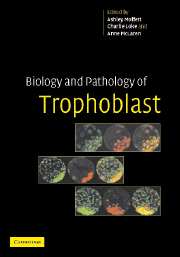Book contents
- Frontmatter
- Contents
- List of contributors
- List of participants
- Preface
- Chair's introduction
- 1 Trophoblast cell fate specification
- 2 Stem cells: pluripotency and extraembryonic differentiation in the mouse
- 3 Epigenetic regulation of trophoblast development
- 4 Regulation of X-chromosome inactivation in relation to lineage allocation in early mouse embryogenesis
- General discussion I
- General discussion II
- 9 Molecular signalling in embryo–uterine interactions during implantation
- 10 Trophoblast and pre-eclampsia
- 11 Trophoblast and uterine mucosal leukocytes
- 12 Immunology of trophoblast: a reappraisal
- Final general discussion
- Index
- Plate section
- References
12 - Immunology of trophoblast: a reappraisal
from General discussion II
Published online by Cambridge University Press: 07 August 2009
- Frontmatter
- Contents
- List of contributors
- List of participants
- Preface
- Chair's introduction
- 1 Trophoblast cell fate specification
- 2 Stem cells: pluripotency and extraembryonic differentiation in the mouse
- 3 Epigenetic regulation of trophoblast development
- 4 Regulation of X-chromosome inactivation in relation to lineage allocation in early mouse embryogenesis
- General discussion I
- General discussion II
- 9 Molecular signalling in embryo–uterine interactions during implantation
- 10 Trophoblast and pre-eclampsia
- 11 Trophoblast and uterine mucosal leukocytes
- 12 Immunology of trophoblast: a reappraisal
- Final general discussion
- Index
- Plate section
- References
Summary
Introduction
In the light of the discovery of the major histocompatibility complex (MHC) and its role in transplantation, the seminal essay written by Medawar drew a logical comparison between an allograft and a fetus (Medawar 1953). Despite being non-self, the fetus survives while the transplant is rejected. Medawar himself pointed out that the placenta must play a central role in fetal acceptance as it is the placental trophoblast cells that interface with the mother. Now, over 50 years later, the question how the allogeneic trophoblast survives in the potentially immunological hostile uterine environment remains unanswered. Why is the solution to this problem so elusive? I would argue that comparing the placental/maternal relationship with the graft/host relationship is misleading because the analogy between the two is not as close as it appears to be.
The extent of cellular contact between trophoblast and maternal tissue will vary significantly between species depending on the type of placentation. The immunological problem is likely to be most acute in the deeply invasive haemochorial placenta used in humans so that the adaptation required and the strategy employed in human reproduction would be expected to be different from those of other species. For this reason, animal models are not very useful and extrapolation of data between species has led to much confusion. The present paper is focused on human placentation.
- Type
- Chapter
- Information
- Biology and Pathology of Trophoblast , pp. 242 - 260Publisher: Cambridge University PressPrint publication year: 2006
References
- 2
- Cited by



